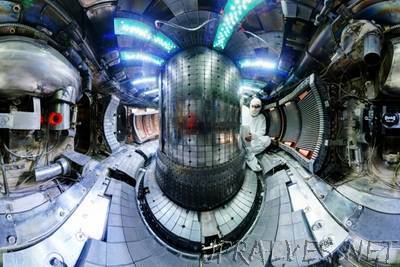
“The Plasma Science and Fusion Center explores a new recipe for heating plasma. In the quest for fusion energy, scientists have spent decades experimenting with ways to make plasma fuel hot and dense enough to generate significant fusion power. At MIT, researchers have focused their attention on using radio-frequency (RF) heating in magnetic confinement fusion experiments like the Alcator C-Mod tokamak, which completed its final run in September 2016. Now, using data from C-Mod experiments, fusion researchers at MIT’s Plasma Science and Fusion Center (PSFC), along with colleagues in Belgium and the UK, have created a new method of heating fusion plasmas in tokamaks. The new method has resulted in raising trace amounts of ions to megaelectronvolt (MeV) energies — an order of magnitude greater than previously achieved. “These higher energy ranges are in the same range as activated fusion products,” PSFC research scientist John C. Wright explains. “To be able to create such energetic ions in a non-activated device — not doing a huge amount of fusion — is beneficial, because we can study how ions with energies comparable to fusion reaction products behave, how well they would be confined.” The new approach, recently detailed in the journal Nature Physics, uses a fuel composed of three ion species: hydrogen, deuterium, and trace amounts (less than 1 percent) of helium-3. Typically, plasma used for fusion research in the laboratory would be composed of two ion species, deuterium and hydrogen or deuterium and He-3, with deuterium dominating the mixture by up to 95 percent. Researchers focus energy on the minority species, which heats up to much higher energies owing to its smaller fraction of the total density. In the new three-species scheme, all the RF energy is absorbed by just a trace amount of He-3 and the ion energy is boosted even more — to the range of activated fusion products. Wright was inspired to pursue this research after attending a lecture in 2015 on this scenario by Yevgen Kasakov, a researcher at the Laboratory for Plasma Physics in Brussels, Belgium, and the lead author of the Nature Physics article. Wright suggested that MIT test these ideas using Alcator C-Mod, with Kasakov and his colleague Jef Ongena collaborating from Brussels. At MIT, PSFC research scientist Stephen Wukitch helped developed the scenario and run the experiment, while Professor Miklos Porkolab contributed his expertise on RF heating. Research scientist Yijun Lin was able to measure the complex wave structure in the plasma with the PSFC’s unique phase contrast imaging (PCI) diagnostic, which was developed over the last two decades by Porkolab and his graduate students. Research scientist Ted Golfinopoulos supported the experiment by tracking the effect of MeV-range ions on measurements of plasma fluctuations. The successful results on C-Mod provided proof of principle, enough to get scientists at the UK’s Joint European Torus (JET), Europe’s largest fusion device, interested in reproducing the results. Like JET, C-Mod operated at magnetic field strength and plasma pressure comparable to what would be needed in a future fusion-capable device. The two tokamaks also had complementary diagnostic capabilities, making it possible for C-Mod to measure the waves involved in the complex wave-particle interaction, while JET was able to directly measure the MeV-range particles.”
